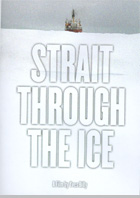
Strait Through The Ice 2007
Distributed by Icarus Films, 32 Court St., 21st Floor, Brooklyn, NY 11201; 800-876-1710
Produced by Yves Billy
Directed by Yves Billy
DVD, color, 52 min.
Sr. High - Adult
Canadian Studies, Ecology, Environmental Studies, Global Warming, Geopolitics, Geography, International Relations
Date Entered: 01/30/2009
Reviewed by Gloria Maxwell, Reference Librarian, Penn Valley Community College, Kansas City, MOThe Arctic ice cap has shrunk to half the size it was 50 years ago. Global warming is causing the North Pole to warm at twice the rate of the rest of the planet. That’s the bad news. The interesting good news is that the mythic Northwest Passage between Asia and Europe has begun to open as the ice rapidly melts. Predictions among scientists are that this ocean passageway may soon be permanently free of ice during its increasingly longer summers. This documentary examines what this means in geopolitical terms among the five nations that border the Arctic Ocean: Canada, Russia, Norway, Denmark, and the U.S. All five nations are making claims to territorial waters, control of sea traffic, and the right to untapped resources of oil and other natural resources. Also at stake is the region’s fragile ecosystem, which is threatened and could be destroyed if traffic is not appropriately regulated. The Northwest Passage provides the shortest route between Europe and Asia, and, with the possible political upheaval related to the Suez Canal, this route provides the greatest potential for a stable political venue. Canada’s port in Vancouver is poised to become part of a major highway. It takes experienced ice navigators to maneuver through these icy waters. Currently, there are not enough captains with this type of experience.
The U.S. argues that Canada’s rights extend only as far as 12 miles off Canadian shores. The European Union shares the U.S. view of the Northwest Passage as being international straits. Russia sides with Canada because it has its own waters it wants to protect. One of the most interesting aspects of this film is the exploration of Canada’s mythic connection to the Northwest Passage, which heightens that country’s claims. The U.S. doesn’t understand Canada’s emotional attachment to this region. Also at play is the fragility of this region and Canada’s concerns about this ecosystem. The film explores some of the past and potential dangers related to oil spills and other environmental disasters. The Inuit natives are Canada’s trump card in providing an historical justification since they are now their own province. On the downside for Canada’s claim is the fact that they don’t have full surveillance capabilities. Canada has less than 250 soldiers and they count on the ice to protect them.
At stake for the U.S. and the other disputing nations are the natural resources this region contains, as well as the economic benefits from traffic moving between Asia and Europe. There will be a race for development as each group tries to solidify their claims. Danger in this region from multiple year ice is an ever present risk.
Strait Through the Ice is a fascinating documentary about a subject that will only increase in importance and visibility as the Arctic ice cap continues to melt at an alarming rate.
The audio and video qualities are very good. Film of actual ships moving through the ice floes is dramatic, while the footage of the Inuit people and of past oil spills is compelling. Interviews and maps provide context. Music supplies a subtle background in select places.
This documentary is appropriate for all types of library collections and would provide excellent discussion points for high school and college classroom discussions, as well as in adult education forums.
Extremely highly recommended.